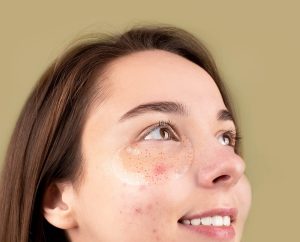Hyaluronic Acid: A Solution for Scar Reduction
Introduction
Scars tell stories—reminders of the body’s incredible healing ability after injury or surgery. However, for many, these marks may cause self-consciousness or discomfort. Fortunately, science offers a remarkable solution in the form of hyaluronic acid. HA is a substance renowned for its potential to reduce scars and rejuvenate skin. Here, this article offers a comprehensive understanding of how hyaluronic acid can be a game-changer in scar reduction and skin rejuvenation!

Hyaluronic Acid for Scar Reduction
Understanding Hyaluronic Acid
Hyaluronic acid is often termed the “fountain of youth.” It is a naturally occurring substance in the human body, and it is primarily found in the skin, connective tissues, and eyes. It plays a crucial role in maintaining moisture, promoting elasticity, and supporting tissue repair.
Related reading: 10 Things All Guys Should Know about Hyaluronic Acid
The Role of Hyaluronic Acid in Scar Reduction
When the skin undergoes injury or trauma, the body initiates a healing process that includes the formation of scars. Hyaluronic acid intervenes in this process. It regulates tissue hydration and inflammation. It also fosters an optimal environment for scar healing.
1. Moisture Retention and Scar Healing
One of hyaluronic acid’s remarkable attributes is its ability to retain moisture. By holding up to 1,000 times its weight in water, it helps keep the skin adequately hydrated during the healing phase. This moisture retention aids in preventing scars from becoming dry and rigid, promoting softer, more pliable scar tissue.
2. Promoting Skin Elasticity and Texture
Scars often alter the skin’s texture and elasticity. This leads to a rough or uneven appearance. Hyaluronic acid contributes to skin hydration and elasticity. This helps smoothen the scar tissue, improve its overall texture, and make it less conspicuous and more akin to the surrounding skin.
3. The Collagen Connection
Collagen is a protein crucial for skin structure. It tends to be disrupted during scar formation. Hyaluronic acid encourages collagen synthesis and aids in the restructuring of scar tissue. This process can lead to a more uniform and aesthetically pleasing appearance of the scar over time.
Related reading: Hyaluronic Acid for Acne Scars Treatments
Clinical Applications and Treatments
Medical professionals frequently employ hyaluronic acid-based treatments to address various types of scars, including surgical scars, acne scars, and keloids. These treatments may include topical applications or injections. In some cases, doctors incorporate it into dressings or gels for sustained release over the scarred area.
Numerous studies explore the impact of hyaluronic acid (HA). One such research endeavor unveiled a pioneering silicone gel blend that merged HA and salts with polysiloxane derivatives. The goal was to elevate the efficacy of scar prevention and amelioration. This innovative gel was assessed using Wistar rats. It demonstrated promising physical and chemical traits alongside notable anti-scar capabilities. [1]
Another study focused on the treatment of keloid scarring. Keloids are characterized by increased growth factor signaling, hyperproliferation, and reduced hyaluronic acid (HA) deposition in the extracellular matrix (ECM). Using high molecular weight HA, the researchers treated five keloid fibroblast cultures and one normal culture for 72 hours.
Results showed reduced proliferation in one keloid culture (KF3), decreased pro-collagen I expression in another (KF2) with modified collagen fiber arrangement, and downregulation of TGF-b1 growth factor expression in KF3 and KF4. Additionally, HA decreased active TGF-b1 release in KF2 and KF5. The findings suggest that high molecular weight HA has the potential to normalize keloid fibroblast features. So, HA offers promise in reducing fibrosis and mitigating keloid manifestations based on specific genotype variations within keloid fibroblast cell lines. [2]
Benefits and Considerations
The use of hyaluronic acid in scar reduction offers several advantages. It’s well-tolerated by most individuals. So, HA minimizes the risk of adverse reactions due to its natural presence in the body, and it typically produces gradual but noticeable improvements in scar appearance.
However, it’s essential to note that while hyaluronic acid treatments can significantly diminish the appearance of scars, complete elimination might not always be feasible. Additionally, individual responses to treatment may vary, requiring personalized approaches for optimal results.
Conclusion
Hyaluronic acid stands as a promising ally in the journey toward scar reduction and skin rejuvenation. Its ability to improve moisture retention, enhance skin texture, and promote collagen production marks it as a valuable component in scar management.
For those seeking to diminish the visibility of scars and restore skin confidence, please consult with a dermatologist or healthcare professional experienced in hyaluronic acid-based treatments. This paves the way toward achieving smoother, more supple skin and reduces the prominence of scars.
Stanford Chemicals Company (SCC) stands as a premier wholesale supplier of pure organic hyaluronic acid (HA) in the USA. We focus on medical-grade, cosmetic-grade, and food-grade HA. Our sodium hyaluronate powder is non-animal derived, ensuring it is Vegan-friendly and compliant with kosher standards. Trust our extensive expertise and varied offerings to meet your specific hyaluronic acid needs across diverse industries and applications.
Reference:
[1] Md. Shoaib Alam, Arif Ansari, Iftikhar Ahsan, Sheikh Shafiq-un-Nabi, Shadab Md, Rasheed A. Shaik, Basma G. Eid, Mohammad Zaki Ahmad, Javed Ahmad (2023). Topical gel containing Polysiloxanes and hyaluronic acid for skin scar: Formulation design, characterization, and In vivo activity. Journal of Cosmetic Dermatology, 22(4), 1220-1232. https://doi.org/10.1111/jocd.15574
[2] Hoffmann A, Hoing JL, Newman M, Simman R. Role of Hyaluronic Acid Treatment in the Prevention of Keloid Scarring. J Am Coll Clin Wound Spec. 2013 Jul 1;4(2):23-31. doi: 10.1016/j.jccw.2013.06.001. PMID: 24936445; PMCID: PMC4054787.
